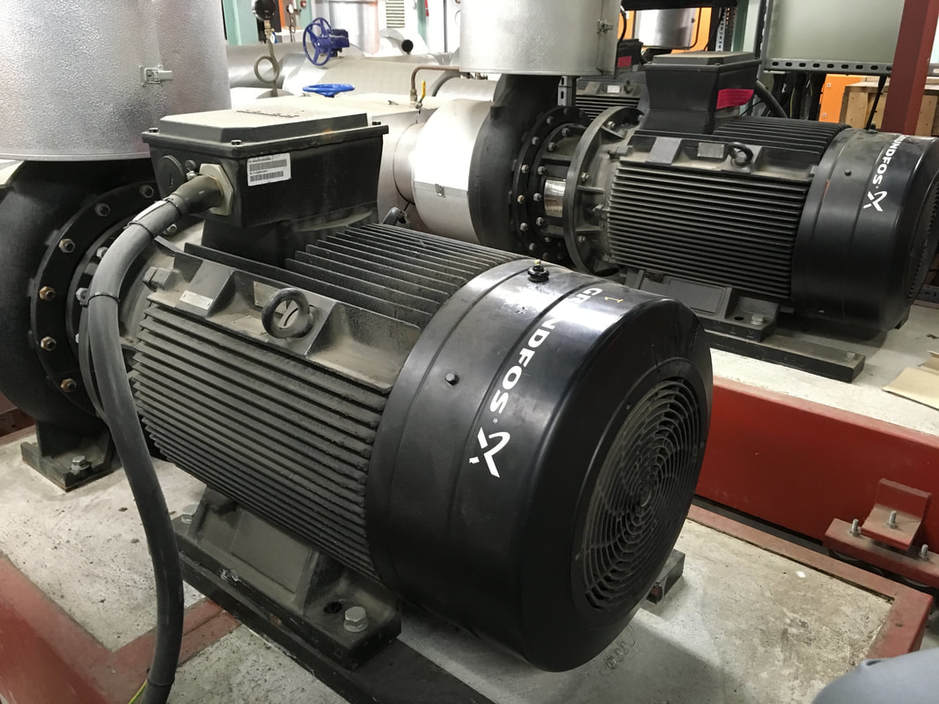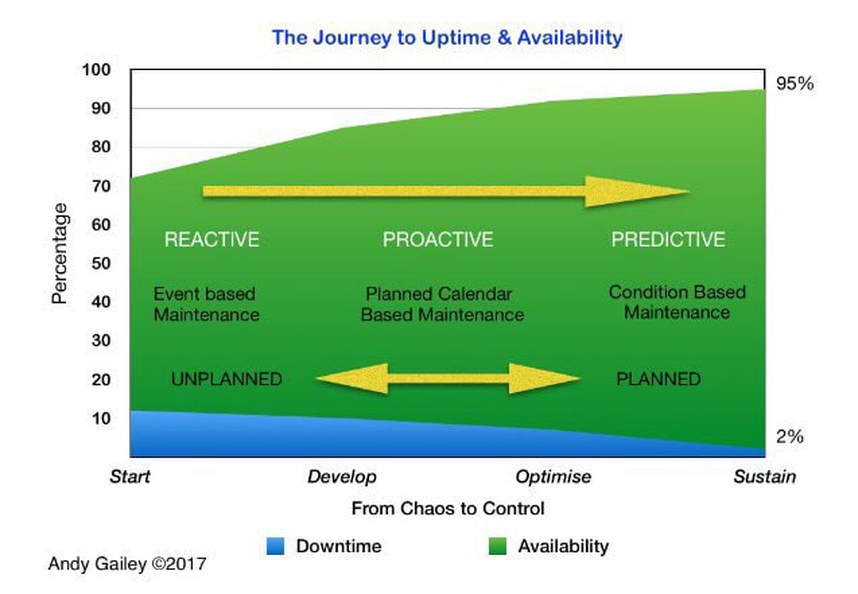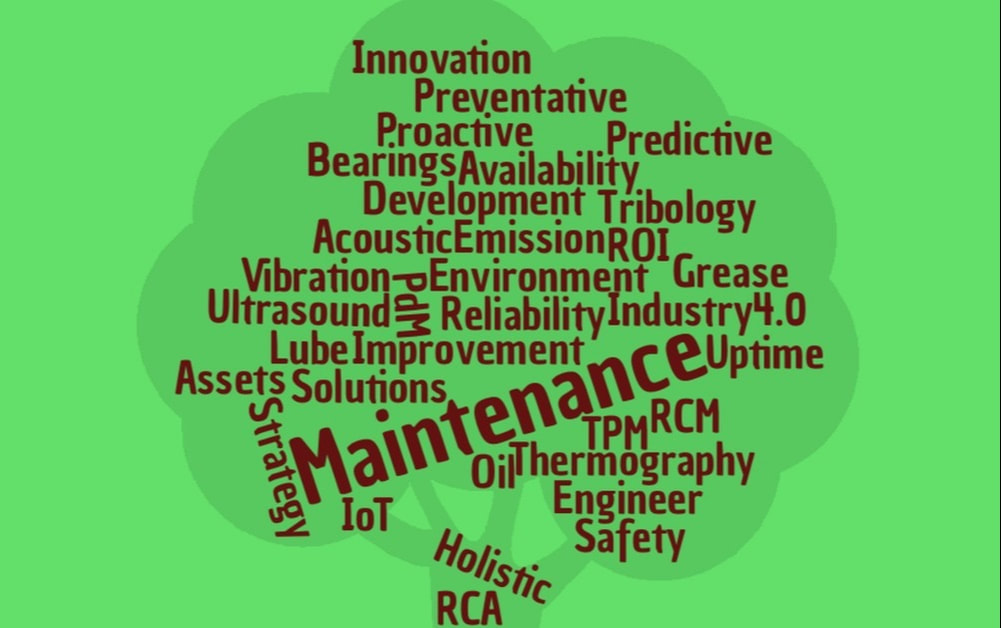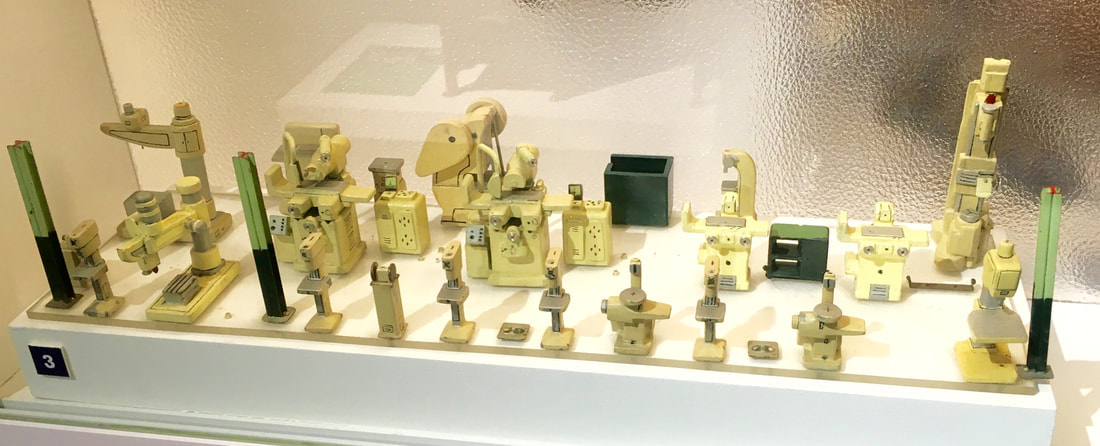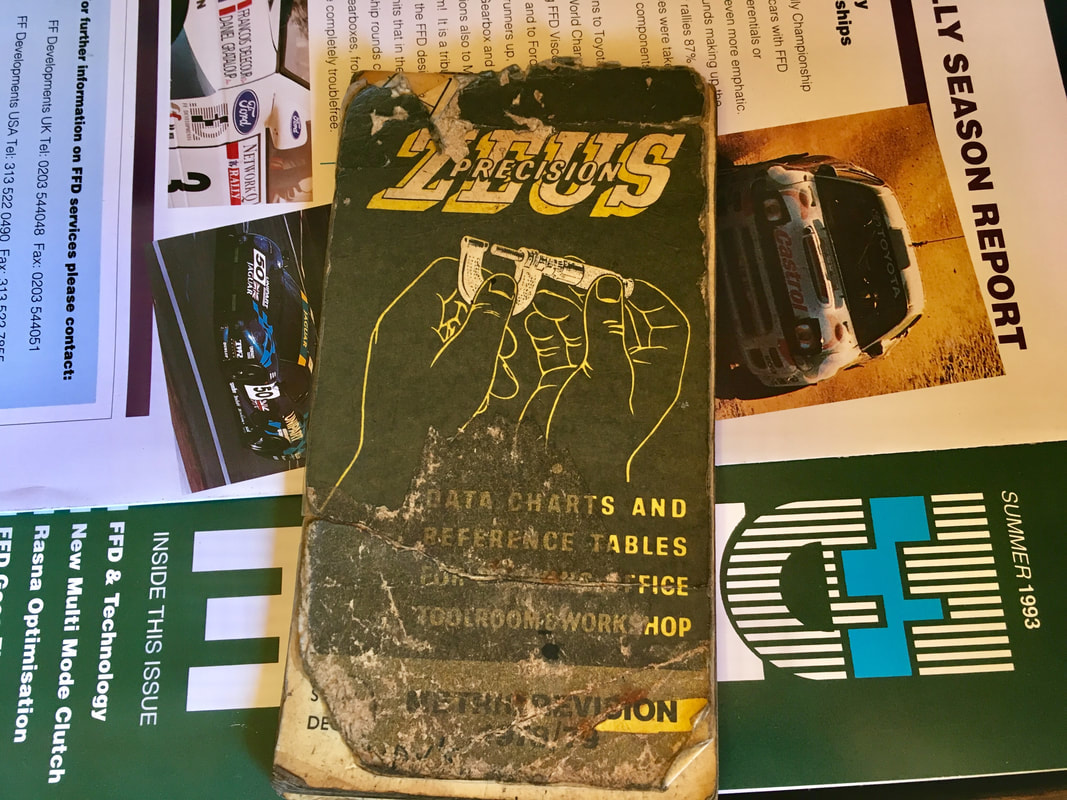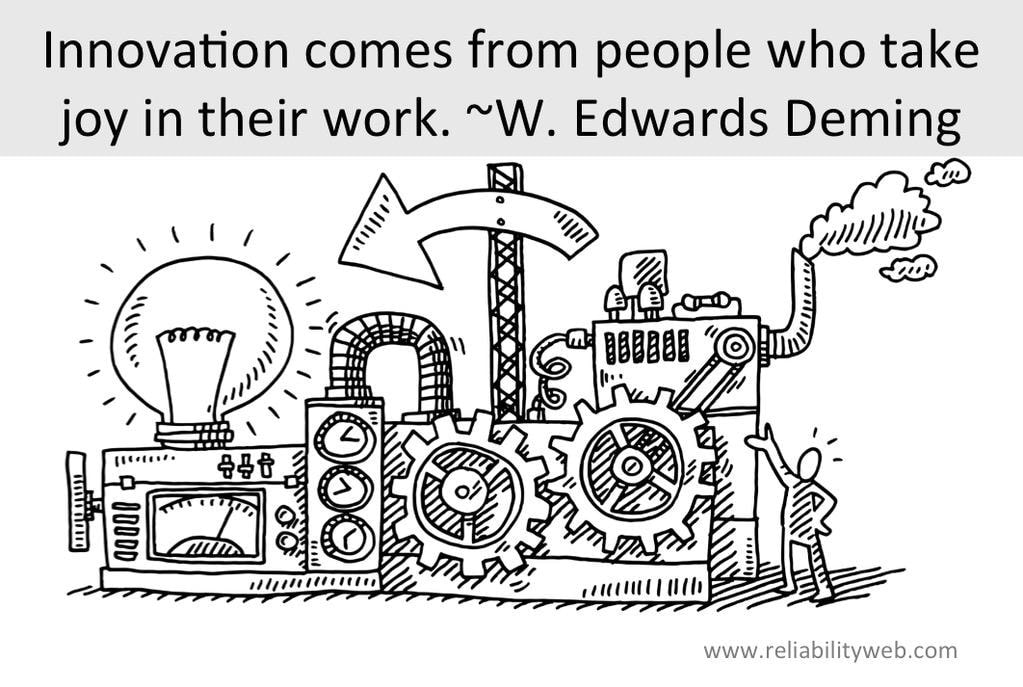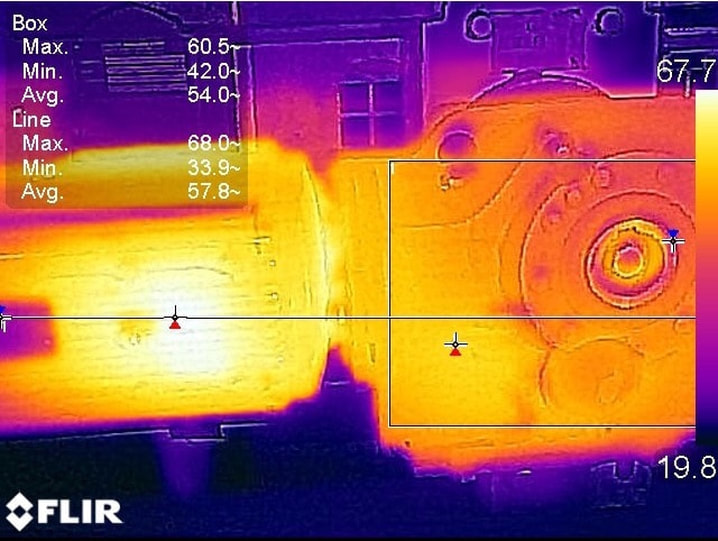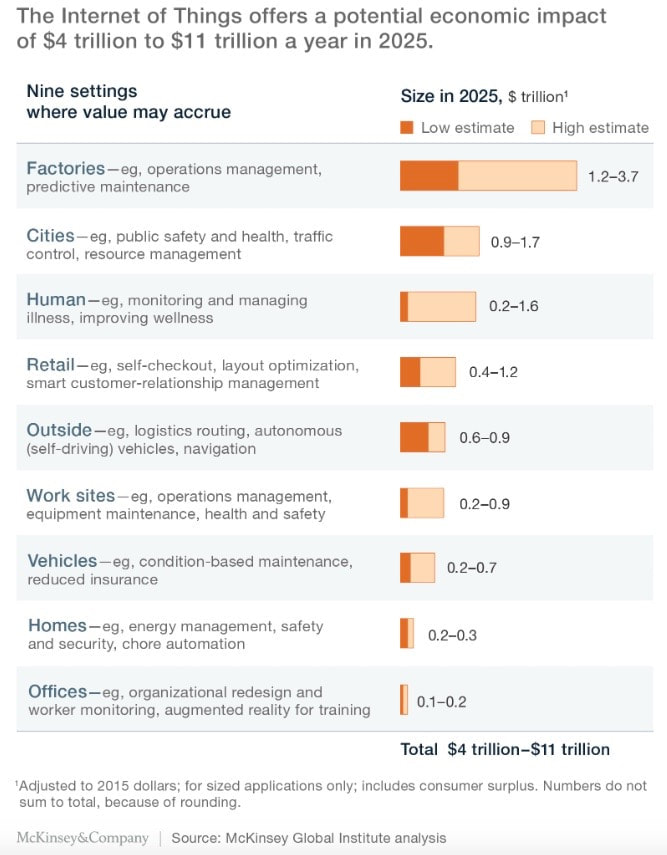The IIoT, RCM and PdM Conundrum
In 2018 the Internet of Things (IoT) is bound to expand as it has done over the last few years. I'm interested in where it will fit into an Industrial setting to achieve maximum value in Productivity and enhance the Reliability of our assets delivering the IIoT (Industrial Internet of Things)
Firstly I will admit that I am no expert on the IIoT, and I would challenge anybody that professed to be one. This fourth industrial revolution is going to be extremely hard to follow because of the enormity of the fields it will cover, and it will do this at a far greater pace than the preceding three industrial revolutions.
Due to the virtual and actual size of the task there are going to be niches where our existing skills can enhance this journey, helping to achieve the professed massive financial gains reported in some IIoT predictions.
It's a really interesting time when we look at this as the IoT has been lead from the consumer industry, whereas previously industry would have taken the lead, it's another aspect that makes it so interesting.
Then there are so many variables involved in the application of the disparate technologies.
Where do we put it?
What is the application?
Are there existing outputs we can already use?
Why?
What's the cost benefit?
What value will it deliver?
These are just some of the questions that will need to be addressed continuously as the systems shift, evolve, improve and develop.
Due to the virtual and actual size of the task there are going to be niches where our existing skills can enhance this journey, helping to achieve the professed massive financial gains reported in some IIoT predictions.
It's a really interesting time when we look at this as the IoT has been lead from the consumer industry, whereas previously industry would have taken the lead, it's another aspect that makes it so interesting.
Then there are so many variables involved in the application of the disparate technologies.
Where do we put it?
What is the application?
Are there existing outputs we can already use?
Why?
What's the cost benefit?
What value will it deliver?
These are just some of the questions that will need to be addressed continuously as the systems shift, evolve, improve and develop.
McKinsey & Company has recently published an estimate of the potential economic impact of IoT projected up until 2025, it's between $3.9 and $11.1 Trillion (yes.. trillion!) of which $1.2 to $3.7 Trillion is expected to be in Manufacturing, Operations Management and Predictive Maintenance (PdM)
I could go on about the projected benefits and figures that would fill this whole article, but I will leave it here to examine some of the more pressing practicalities.
Most people I talk to in industry have a day to day job to do, they are not sure of what IIoT means to them or where to start, I can understand their caution, how can you make decisions if you can't grasp or quantify the benefits to your operations? This is where I would advise a lot of background work to be done ahead of any heavy investments in technology, quantifying the applications, costs and benefits first.
I am interested in safety, productivity and reliability of industrial assets so all of my thoughts here will reflect upon those aspects. For me, reliability, productivity and safety all interact, reliable operations are safer and are more productive.
How can we bring together IIoT, RCM (Reliability Centred Maintenance) and PdM (Predictive Maintenance) to drive savings in time, money, resources and labour at the same time? Do we want to? What's the strategy? Can it deliver? Again, some questions that will require answering ahead of any implementation process.
Operations with foresight will have a structured Maintenance strategy that will have been through an RCM process and will have continued to live with RCM in continuous development, this is my view and you can disagree if you want, all I know is that I have lived it and witnessed it working in practice.
Unfortunately this is not common in my experience, some well established organisations grow up with a maintenance function that acts mostly reactively, heavily reliant on Planned Maintenance (PM) programs with a standard cycle of break, fix, sleep, repeat. They carry out and 'score' PM schedules like a never ending game, it becomes a means to an end that nobody can justify or quantify!
Some will thrive on this cycle as it 'keeps people busy' and they may feel more valued carrying out reactive fire fighting work in the field. It can bring rewards with celebrations and back slapping all round but is it really delivering best value?
Often they live with this as they have no idea of how to break the cycle and take back control of their assets, working reactively the assets will control you, they decide where you work and they will drive when and how you are deployed.
A developed RCM program will involve some PdM to give early warning of equipment degradation whilst tracking asset health. With an RCM strategy the PdM can be properly targeted towards the assets that pose the greatest risk to safety, productivity and reliability, avoiding the consequences of failure is the name of the game.
Some miss this point completely and overdo the PdM program, collating loads of data with no idea of the benefits or avoidance of consequences. I have seen this before and it's an interesting conversation when I ask about the proven cost benefits!
Most people I talk to in industry have a day to day job to do, they are not sure of what IIoT means to them or where to start, I can understand their caution, how can you make decisions if you can't grasp or quantify the benefits to your operations? This is where I would advise a lot of background work to be done ahead of any heavy investments in technology, quantifying the applications, costs and benefits first.
I am interested in safety, productivity and reliability of industrial assets so all of my thoughts here will reflect upon those aspects. For me, reliability, productivity and safety all interact, reliable operations are safer and are more productive.
How can we bring together IIoT, RCM (Reliability Centred Maintenance) and PdM (Predictive Maintenance) to drive savings in time, money, resources and labour at the same time? Do we want to? What's the strategy? Can it deliver? Again, some questions that will require answering ahead of any implementation process.
Operations with foresight will have a structured Maintenance strategy that will have been through an RCM process and will have continued to live with RCM in continuous development, this is my view and you can disagree if you want, all I know is that I have lived it and witnessed it working in practice.
Unfortunately this is not common in my experience, some well established organisations grow up with a maintenance function that acts mostly reactively, heavily reliant on Planned Maintenance (PM) programs with a standard cycle of break, fix, sleep, repeat. They carry out and 'score' PM schedules like a never ending game, it becomes a means to an end that nobody can justify or quantify!
Some will thrive on this cycle as it 'keeps people busy' and they may feel more valued carrying out reactive fire fighting work in the field. It can bring rewards with celebrations and back slapping all round but is it really delivering best value?
Often they live with this as they have no idea of how to break the cycle and take back control of their assets, working reactively the assets will control you, they decide where you work and they will drive when and how you are deployed.
A developed RCM program will involve some PdM to give early warning of equipment degradation whilst tracking asset health. With an RCM strategy the PdM can be properly targeted towards the assets that pose the greatest risk to safety, productivity and reliability, avoiding the consequences of failure is the name of the game.
Some miss this point completely and overdo the PdM program, collating loads of data with no idea of the benefits or avoidance of consequences. I have seen this before and it's an interesting conversation when I ask about the proven cost benefits!
The title "The IIoT, RCM and PdM Conundrum" refers to a fine balance and holistic view to achieve the best results, my chosen path would be RCM - PdM - IIoT with some overlap of these. If you start too heavy on PdM it will add little or no value, guide this with RCM and it will return the best value, finally choose your IIoT solution, it sounds easy! There are a range of solutions out there being offered at the moment and some may or may not suit your needs. My advice would be to start small, prove it works then scale it up to cover more assets.
I also like to look back to see what I have seen work in the past, then aim to transpose that forward to find a new solution. If we carry out our maintenance 'properly' our assets should perform at the level and standard we wish them to. By utilising RCM we can continuously improve our plan using PdM where it provides best value, always have your eyes on the process, what is it doing, how is it performing, what wastes are there, what do the operators say, these are some of the most important aspects available to help deliver safer more productive and reliable operation.
Taking all this into account I would want an IIoT solution to take Maintenance, Operations, Predictive and Human outputs together to give me an idea of what may happen in the near future so that I have as much information as possible to plan my resources. The IIoT solution needs to continuously learn about the assets to improve the overall system and speak in a common language. The solution would have to take a holistic view of the assets, people, skills, tools and system interactions, a new type of strategy is therefore required.
I also like to look back to see what I have seen work in the past, then aim to transpose that forward to find a new solution. If we carry out our maintenance 'properly' our assets should perform at the level and standard we wish them to. By utilising RCM we can continuously improve our plan using PdM where it provides best value, always have your eyes on the process, what is it doing, how is it performing, what wastes are there, what do the operators say, these are some of the most important aspects available to help deliver safer more productive and reliable operation.
Taking all this into account I would want an IIoT solution to take Maintenance, Operations, Predictive and Human outputs together to give me an idea of what may happen in the near future so that I have as much information as possible to plan my resources. The IIoT solution needs to continuously learn about the assets to improve the overall system and speak in a common language. The solution would have to take a holistic view of the assets, people, skills, tools and system interactions, a new type of strategy is therefore required.
I believe we now have the Prognostic tools to start to deliver this vision
The other subject we need to be mindful of is skills, not just the IoT knowledge and skills to apply the different prognostic tools, but front line competence to manage those outputs and deliver value to the production process.
There is bound to be a learning phase where the prognostics will have to find out how the assets operate and interact, the outputs will generate actions for humans to inspect the assets when abnormal limits are triggered remotely, these actions obviously have to be fed back into the prognostic tool. This will be a learning curve both for the tools and the engineers on the front line, it's a journey that will have to be embraced by personnel to make it work. It will take months and years of perseverance, not weeks, to achieve a steady state with commitment from all quarters.
The next issue involves the decision making and front line diagnostics that have to be carried out before removing, reworking or repairing assets, these skills are generally reducing, training will need to be ongoing with operations and engineering talking about the process stream as a whole, not as individual silos or discrete work areas. Mindsets will need to be reeducated to achieve the real long term benefits from this emerging technology.
Recently someone told me that it's not ready yet, my own view is that we have to do it now, it's not an option to wait, we may need to fail a little, learn quickly, get to the next iteration and move on constantly to achieve the end goal.
There is bound to be a learning phase where the prognostics will have to find out how the assets operate and interact, the outputs will generate actions for humans to inspect the assets when abnormal limits are triggered remotely, these actions obviously have to be fed back into the prognostic tool. This will be a learning curve both for the tools and the engineers on the front line, it's a journey that will have to be embraced by personnel to make it work. It will take months and years of perseverance, not weeks, to achieve a steady state with commitment from all quarters.
The next issue involves the decision making and front line diagnostics that have to be carried out before removing, reworking or repairing assets, these skills are generally reducing, training will need to be ongoing with operations and engineering talking about the process stream as a whole, not as individual silos or discrete work areas. Mindsets will need to be reeducated to achieve the real long term benefits from this emerging technology.
Recently someone told me that it's not ready yet, my own view is that we have to do it now, it's not an option to wait, we may need to fail a little, learn quickly, get to the next iteration and move on constantly to achieve the end goal.
If we have to wait for a perfect solution we will be waiting a very long time
Now my take on what the future may hold. I am intrigued by what will happen in the next five or ten years not just tomorrow, let me know what you think in a comment on this post. Part of me writing these articles about IIoT (the first was last July) is to look back in a few years and see if I was on point or way off the mark!
I believe that assets and production plants actually 'live' almost like an analogue being, they possess a heartbeat, the more complex they become the more they have this ability to live. I have come across some sceptics that believe the opposite, mainly because most things now are digitally driven. The latest thinking though is that this digital age is a stepping stone to the next giant leap forward and analogue will drive that next big advance.
When you think about it Google and Facebook are already doing this with their algorithms, they are the main protagonists of analogue now.
Machines of the future may be digital, analogue and biochemical all at the same time!
The highest form of analogue being after all is us... the human.
These views are all my own based on my experiences, reading and thinking, if you have other views or ideas then please take the next step and write an article of your own, you may enjoy it.
I believe that assets and production plants actually 'live' almost like an analogue being, they possess a heartbeat, the more complex they become the more they have this ability to live. I have come across some sceptics that believe the opposite, mainly because most things now are digitally driven. The latest thinking though is that this digital age is a stepping stone to the next giant leap forward and analogue will drive that next big advance.
When you think about it Google and Facebook are already doing this with their algorithms, they are the main protagonists of analogue now.
Machines of the future may be digital, analogue and biochemical all at the same time!
The highest form of analogue being after all is us... the human.
These views are all my own based on my experiences, reading and thinking, if you have other views or ideas then please take the next step and write an article of your own, you may enjoy it.
Industrial Internet of Things Matters
How will the Industrial Internet of Things impact the industry of the future?
During my career as an engineer I have been lucky enough to witness some remarkable developments over the past forty years. When I started everything was still very manual, draftsmen designed on paper or film, machinists worked to micrometers and verniers, planners worked with cardex systems and inspection was a time consuming manual vocation.
Above photo shows how a machine shop was planned out using models, no CAD!
Photo by Uptime Consultant, British Motor Museum, Gaydon, Warwickshire, UK
Photo by Uptime Consultant, British Motor Museum, Gaydon, Warwickshire, UK
I first saw digital devices appear in manufacturing in the 1980s and by the 90s NC machines were the benchmark, within a decade CNC had become the norm. In drafting I remember the first primitive CAD system being installed where I then worked, it was seen as a time consuming 'toy' to some of the draftsmen who were mathematicians as no PCs existed then, only calculators (some still used a slide rule).
I thought it was great to see, learn and use all of these innovations and I still do, that's why I'm so interested to see how the Industrial Internet of Things (IIoT) will pan out over the next few years.
I thought it was great to see, learn and use all of these innovations and I still do, that's why I'm so interested to see how the Industrial Internet of Things (IIoT) will pan out over the next few years.
1978/79 Zeus Precision tables that spent a few years in the top pocket of my overalls
The industries I am most experienced in are Production and Development and all I say here is taken from that sphere but could be transferred to other sectors.
What I see now is a need for integration of some of the tools and technologies that already exist, I believe the real gains will be made in connectivity. IIoT is a popular subject at the moment, there's a lot of 'noise' from hardware and software developers saying all this can be realised already, I'm still to be convinced, perhaps it's the engineer in me or maybe the sceptic!
I think we still have a long way to go and even some big boys in the industry are shifting their focus from total solutions; one major player has just withdrawn from the internet part of the picture. In a previous article on IIoT I looked at the constraints from the lack of available investment in industry to the reticence to onboard new technology. I can understand this, capital may be in short supply, there's a long gestation period for this type of expenditure, by the time it is up and running it may already be out of date, also if they are anything like me tend to avoid the initial iteration of most technologies (never buy the newest generation iPhone or Samsung until the bugs are fixed!)
Casting our minds back to the analogue world is where these technology providers may be best to start. Again in my experience with production I always stand back and take in the whole process, the machinery, people, variables in production, process flow, key indicators, what the customer/consumer required, scrap rate, rework, operational plan, I always take in the whole picture.
If we want to achieve real value from the IIoT allied to a process industry these are the attributes it will need to bring together in real time to add maximum value. We already do this in industry when we bring information from process outputs together with predictive technology, information from process experts, throughput targets and other operational data. This methodology already adds real value when managed correctly.
What I see now is a need for integration of some of the tools and technologies that already exist, I believe the real gains will be made in connectivity. IIoT is a popular subject at the moment, there's a lot of 'noise' from hardware and software developers saying all this can be realised already, I'm still to be convinced, perhaps it's the engineer in me or maybe the sceptic!
I think we still have a long way to go and even some big boys in the industry are shifting their focus from total solutions; one major player has just withdrawn from the internet part of the picture. In a previous article on IIoT I looked at the constraints from the lack of available investment in industry to the reticence to onboard new technology. I can understand this, capital may be in short supply, there's a long gestation period for this type of expenditure, by the time it is up and running it may already be out of date, also if they are anything like me tend to avoid the initial iteration of most technologies (never buy the newest generation iPhone or Samsung until the bugs are fixed!)
Casting our minds back to the analogue world is where these technology providers may be best to start. Again in my experience with production I always stand back and take in the whole process, the machinery, people, variables in production, process flow, key indicators, what the customer/consumer required, scrap rate, rework, operational plan, I always take in the whole picture.
If we want to achieve real value from the IIoT allied to a process industry these are the attributes it will need to bring together in real time to add maximum value. We already do this in industry when we bring information from process outputs together with predictive technology, information from process experts, throughput targets and other operational data. This methodology already adds real value when managed correctly.
The challenge will be to integrate all these outputs into software that will give real time results based on appropriate rules, sounds easy doesn't it!
The issue with some (that have not worked in the industry) is that they can assume production processes are straight line and very 'mechanical', in my experience this gets further from the truth as the system becomes more complex, I always view processes as living systems that have a 'heartbeat', a natural rhythm where control can be maintained and flat line, disrupting any part can result in a domino effect that can cause poor levels of production, increased scrap or damage to individual assets.
Another issue is that it's not a binary problem as anyone with a few years working in a production environment can tell you, there a lot of variables and some of the desires of operations may not fit in with a fully integrated IIoT system. Whoever comes up with a solution that is timely and cost effective (notice I didn't say cheap) will be the winners of a big opportunity.
There are many hurdles to overcome including security, connectivity, maintenance (of the new systems), capital investment costs, ROI, integrity and a few more that I'm sure you can think of.
For my small part I am helping to develop a low cost versatile PdM device that can provide part of that Industrial Internet of Things to add value at an operational level.
Another issue is that it's not a binary problem as anyone with a few years working in a production environment can tell you, there a lot of variables and some of the desires of operations may not fit in with a fully integrated IIoT system. Whoever comes up with a solution that is timely and cost effective (notice I didn't say cheap) will be the winners of a big opportunity.
There are many hurdles to overcome including security, connectivity, maintenance (of the new systems), capital investment costs, ROI, integrity and a few more that I'm sure you can think of.
For my small part I am helping to develop a low cost versatile PdM device that can provide part of that Industrial Internet of Things to add value at an operational level.
The Industrial Internet of Things and Human
(not Artificial) Intelligence
In a previous article I examined the IIoT or Industry 4.0 and some of the obstacles to be overcome for it to thrive in an industrial setting
Anthony Gormley's 'Apart X' from 2002 in the Palm Springs Art Museum Andy Gailey ©2017
When people talk about IIoT and I4.0 they often link it to the innovation of Artificial Intelligence (AI), this got me thinking again.
The focus at the moment seems to be about the challenges of managing big data that may come from disparate systems to enhance availability, productivity and reliability.
Sensors that can operate in harsh industrial environments with wireless connectivity that are robust with increased battery life are a few of the developments that have taken place so far.
Bringing together process outputs of temperature, speed, pressure, flow and volume along with Predictive Maintenance (PdM) measurements of vibration, ultrasound, oil quality and thermography may pose a more complicated issue.
Most Predictive or Condition Monitoring Engineers will understand that this is where the real benefits occur, when to act, how to act, what are the probable consequences and is there a benefit to be realised?
The data in itself is just that, data. The thought process and planning to return the asset to it's steady state is where the skill lies. Almost anyone can take PdM readings and harvest data, the benefit is in what to do with it, when to take action or leave well alone.
The focus at the moment seems to be about the challenges of managing big data that may come from disparate systems to enhance availability, productivity and reliability.
Sensors that can operate in harsh industrial environments with wireless connectivity that are robust with increased battery life are a few of the developments that have taken place so far.
Bringing together process outputs of temperature, speed, pressure, flow and volume along with Predictive Maintenance (PdM) measurements of vibration, ultrasound, oil quality and thermography may pose a more complicated issue.
Most Predictive or Condition Monitoring Engineers will understand that this is where the real benefits occur, when to act, how to act, what are the probable consequences and is there a benefit to be realised?
The data in itself is just that, data. The thought process and planning to return the asset to it's steady state is where the skill lies. Almost anyone can take PdM readings and harvest data, the benefit is in what to do with it, when to take action or leave well alone.
These Human Intelligence processes will have to be duplicated by statisticians, computer scientists and application engineers to become autonomous, I believe (I'm no expert as you can see).
This may lead to increased centralisation of the data away from the operation or facility. Trigger levels to take action will have to develop over time as the system learns what a failure event 'looks' like, some failures may have to be experienced before the system has learnt how they behave to complete the model. This is one thing good PdM practitioners aims to avoid and few robust programs should experience such failures by taking pre-emptive action.
Considering this I believe that Human rather than Artificial Intelligence will still be required for some time to work along side AI to authorise and implement solutions using IIoT as a very sophisticated tool.
As discussed in my previous IoT article some of the constraints will be around Return On Investment (ROI) and the lag of capital investment in the technology. Personally I am very keen on investigating ROI at the outset when considering implementing current PdM techniques and tools.
It can be justified in most totally reactive operations but I find there's still a reticence to invest even when there is a case for it. In more proactive environments it requires more work to justify, the status quo of a Planned Maintenance (PM) heavy schedule requires a shift in outlook, some companies have to be weaned off their crutch of invasive time consuming fixed time maintenance.
Deployment of sophisticated connected devices may prove more difficult to justify ROI, their price is coming down but they are still an investment in hardware that in itself will have failure modes and require maintenance!
The assets that have ROI are either highly critical or of a very high risk and safety value. This is where connected devices already exist as we fly around the world in planes with engines tracked and continuously monitored by their manufacturer in real time.
Getting back to the Human and Artificial Intelligence part of this article; imagine the AI has now learnt and developed so that it can accurately predict future failures precisely. This now relegates the Human Intelligence (Engineer/Maintainer) to a changer of parts or systems by remote control, assuming the AI is centralised, how will this feel?
This may lead to increased centralisation of the data away from the operation or facility. Trigger levels to take action will have to develop over time as the system learns what a failure event 'looks' like, some failures may have to be experienced before the system has learnt how they behave to complete the model. This is one thing good PdM practitioners aims to avoid and few robust programs should experience such failures by taking pre-emptive action.
Considering this I believe that Human rather than Artificial Intelligence will still be required for some time to work along side AI to authorise and implement solutions using IIoT as a very sophisticated tool.
As discussed in my previous IoT article some of the constraints will be around Return On Investment (ROI) and the lag of capital investment in the technology. Personally I am very keen on investigating ROI at the outset when considering implementing current PdM techniques and tools.
It can be justified in most totally reactive operations but I find there's still a reticence to invest even when there is a case for it. In more proactive environments it requires more work to justify, the status quo of a Planned Maintenance (PM) heavy schedule requires a shift in outlook, some companies have to be weaned off their crutch of invasive time consuming fixed time maintenance.
Deployment of sophisticated connected devices may prove more difficult to justify ROI, their price is coming down but they are still an investment in hardware that in itself will have failure modes and require maintenance!
The assets that have ROI are either highly critical or of a very high risk and safety value. This is where connected devices already exist as we fly around the world in planes with engines tracked and continuously monitored by their manufacturer in real time.
Getting back to the Human and Artificial Intelligence part of this article; imagine the AI has now learnt and developed so that it can accurately predict future failures precisely. This now relegates the Human Intelligence (Engineer/Maintainer) to a changer of parts or systems by remote control, assuming the AI is centralised, how will this feel?
It will remove the decision making and accepting de-skilling in this area will become normal. Engineers and Technicians are motivated by involvement and as we know the number of skilled engineers is dwindling at a greater rate than we can replace them. How many times do engineers suspect a part in a system only to find out there's another cause that leads to more skill required as the job escalates. We could end up with semi-skilled service maintainers lost in a sea of recurring faults that they have no idea how to address.
What will happen if an unplanned failure occurs when the maintainer has carried out the instruction but the root cause wasn't realised? Does the AI get called into the office? What if the maintainer or engineering disagrees and doesn't carry out the work because they can see it is flawed? Who will be responsible and accountable? These are the questions that interest me.
Let us now imagine the AI does not accurately predict future failures. It may aim too high or too low resulting in work that's not required or misses the P-F (Potential-Functional) interval and the equipment crashes. How will the humans react to this, will they feel confident or will they tend to dismiss the technology? Reliability and Predictive Maintenance engineers will know how this feels sometimes!
I always say that if you are at the sharp end of PdM you are sometimes only recognised for the last unplanned event you didn't predict!
The centralisation of the ultimate AI system could take all the decision making away from the local operation, this may lead to conflicts as a remote operator instructs front line or field personnel to intervene when not required.
My experience in PdM and CBM has taught me that eyes and ears on the ground often trumps predictive technology. Visual inspections and being present working with the assets you get a feel for things, you may notice a weeping seal that's not quite leaking yet but you'll note it and keep an eye on it.
Little things like this prove very hard if not impossible to integrate into an IIoT system, and most of the losses come from all these little issues not really the big attention gathering show stoppers.
Fully integrated IoT in industry is still a few years away and I am looking forward to seeing what goes on and where it develops over the next decade. I believe a stepped approach will need to be taken from a local level while the AI learns and develops the P-F intervals, the maintainers inputting as many failure modes and past data to aid the system.
By co-opting the front line Human Intelligence to support and develop the IIoT you could end up with a very powerful tool indeed, and we have to remember it's a tool. It's function is to serve the Process and Customer and to provide a return on the time, money and effort invested in it.
These are all my own off the wall educated guesses, and that's all we can do at the moment, speculate and guess. What's your take on it? How do you think the technology will develop?
It's going to be an interesting journey, why not comment and join the debate, it's no good sitting on fences as life is too short!
What will happen if an unplanned failure occurs when the maintainer has carried out the instruction but the root cause wasn't realised? Does the AI get called into the office? What if the maintainer or engineering disagrees and doesn't carry out the work because they can see it is flawed? Who will be responsible and accountable? These are the questions that interest me.
Let us now imagine the AI does not accurately predict future failures. It may aim too high or too low resulting in work that's not required or misses the P-F (Potential-Functional) interval and the equipment crashes. How will the humans react to this, will they feel confident or will they tend to dismiss the technology? Reliability and Predictive Maintenance engineers will know how this feels sometimes!
I always say that if you are at the sharp end of PdM you are sometimes only recognised for the last unplanned event you didn't predict!
The centralisation of the ultimate AI system could take all the decision making away from the local operation, this may lead to conflicts as a remote operator instructs front line or field personnel to intervene when not required.
My experience in PdM and CBM has taught me that eyes and ears on the ground often trumps predictive technology. Visual inspections and being present working with the assets you get a feel for things, you may notice a weeping seal that's not quite leaking yet but you'll note it and keep an eye on it.
Little things like this prove very hard if not impossible to integrate into an IIoT system, and most of the losses come from all these little issues not really the big attention gathering show stoppers.
Fully integrated IoT in industry is still a few years away and I am looking forward to seeing what goes on and where it develops over the next decade. I believe a stepped approach will need to be taken from a local level while the AI learns and develops the P-F intervals, the maintainers inputting as many failure modes and past data to aid the system.
By co-opting the front line Human Intelligence to support and develop the IIoT you could end up with a very powerful tool indeed, and we have to remember it's a tool. It's function is to serve the Process and Customer and to provide a return on the time, money and effort invested in it.
These are all my own off the wall educated guesses, and that's all we can do at the moment, speculate and guess. What's your take on it? How do you think the technology will develop?
It's going to be an interesting journey, why not comment and join the debate, it's no good sitting on fences as life is too short!
Uptime Consultant Training CBM and Condition Monitoring techniques with ENGIE Engineers
When will The Internet of Things (IoT) Shape Industry?
Word on the street is IoT is going to have a massive impact on all aspects of our lives.
But when will we really see IoT disrupt Industry?
But when will we really see IoT disrupt Industry?
©2017 Andy Gailey
SEW Motor Gearbox Thermal Image taken with FLIR One on iPhone SE edited in FLIR Tools by Uptime Consultant Ltd
We have seen IoT starting to edge into our everyday life through new consumer products in our homes and offices. I'm wondering how long will it take for interactive devices to become prevalent in the Industrial Internet of Things (IIoT)
I can understand how consumer devices are on the forefront of IoT as we have become used to upgrading devices and have readily accepted connected technology into our homes with interactive TVs and other equipment.
We can now control lots of electronic devices including security cameras from anywhere on the planet!
My interest is in the Industrial sector where the major benefits are going to be realised by IoT connectivity.
When, what, why, how and where is what we need to look at for our industrial applications.
You don't have to look far for IIoT articles claiming that it's all going to happen tomorrow; usually by hardware manufacturers that say it's all available today.
I have been digesting these over the past few months and now have my own outlook (and we are all guessing!) on the answers to the above questions.
Contrary to the "It's going to happen tomorrow" articles I believe it's going to take a while, there you go I said it!
When it does eventually become everyday it will probably throw up more issues that the technology may not be able to solve readily, I will cover that later on.
So what does McKinsey say?
They have recently published an estimation of the potential economic impact of IoT projected up until 2025 and it's between $3.9 and $11.1 Trillion (yep trillion!) of which $1.2 to $3.7 Trillion is expected to be within Manufacturing including Operations Management and Predictive Maintenance.
This is currently referred to as part of Industry 4.0 in most industrial settings.
These are massive figures so we all need to sit up and pay attention; for some perspective the UKs national debt not including loads of other liabilities is around £1.7 Trillion and rising, so IIoT may be able to pay off the national debt!
Take a look at McKinsey's chart below to see their breakdown with the Industrial sector sitting at the top.
We can now control lots of electronic devices including security cameras from anywhere on the planet!
My interest is in the Industrial sector where the major benefits are going to be realised by IoT connectivity.
When, what, why, how and where is what we need to look at for our industrial applications.
You don't have to look far for IIoT articles claiming that it's all going to happen tomorrow; usually by hardware manufacturers that say it's all available today.
I have been digesting these over the past few months and now have my own outlook (and we are all guessing!) on the answers to the above questions.
Contrary to the "It's going to happen tomorrow" articles I believe it's going to take a while, there you go I said it!
When it does eventually become everyday it will probably throw up more issues that the technology may not be able to solve readily, I will cover that later on.
So what does McKinsey say?
They have recently published an estimation of the potential economic impact of IoT projected up until 2025 and it's between $3.9 and $11.1 Trillion (yep trillion!) of which $1.2 to $3.7 Trillion is expected to be within Manufacturing including Operations Management and Predictive Maintenance.
This is currently referred to as part of Industry 4.0 in most industrial settings.
These are massive figures so we all need to sit up and pay attention; for some perspective the UKs national debt not including loads of other liabilities is around £1.7 Trillion and rising, so IIoT may be able to pay off the national debt!
Take a look at McKinsey's chart below to see their breakdown with the Industrial sector sitting at the top.
So back down on Earth, how is this going to work in Industry?
From my limited 35 years experience working across manufacturing I believe it will be slow to react and the timescales long.
Production Industry is quite conservative in it's approach and investment, that's why many still work in a reactive way. Financial plans look at 5 or 10 years and likewise investment in new plant and equipment is planned on similar payback with the assets expected to have a lifespan of 20+ years.
Two areas McKinsey & Company identify against 'Factory' are Operations Management and Predictive Maintenance; that's interesting as I'm keen on improving both.
If you ask me the two main areas Industry still lags is these two, Operations in the main sticks to tradition and Predictive Maintenance in manufacturing is still regarded as witchcraft!
Many still prefer the status quo of 'break and fix', they are comfortable with fire fighting and heroes saving the day (commence hi fives and backslaps); in the IIoT there's nothing here to connect!
There has to be a paradigm shift in attitude, thinking and application from the very top of an organisation to initiate this change; it rarely happens with new Operations platforms and Predictive Maintenance, so why do we think everyone will repent and embrace IIoT?
Below is the bit I said I would get to later:
From my limited 35 years experience working across manufacturing I believe it will be slow to react and the timescales long.
Production Industry is quite conservative in it's approach and investment, that's why many still work in a reactive way. Financial plans look at 5 or 10 years and likewise investment in new plant and equipment is planned on similar payback with the assets expected to have a lifespan of 20+ years.
Two areas McKinsey & Company identify against 'Factory' are Operations Management and Predictive Maintenance; that's interesting as I'm keen on improving both.
If you ask me the two main areas Industry still lags is these two, Operations in the main sticks to tradition and Predictive Maintenance in manufacturing is still regarded as witchcraft!
Many still prefer the status quo of 'break and fix', they are comfortable with fire fighting and heroes saving the day (commence hi fives and backslaps); in the IIoT there's nothing here to connect!
There has to be a paradigm shift in attitude, thinking and application from the very top of an organisation to initiate this change; it rarely happens with new Operations platforms and Predictive Maintenance, so why do we think everyone will repent and embrace IIoT?
Below is the bit I said I would get to later:
"IIoT can't change culture but can only work with a culture change"
As a pragmatic Production Engineer my money is on the medium to long term for more than just the cultural reasons described above.
Some of my time has been spent using Predictive Maintenance technology on the front line and latterly advising or training others to choose the technology wisely and selectively.
For the IIoT to actually work at least all of the critical equipment in plant will have sensors attached or ideally implanted during manufacture; some servo motors are already capable of reporting their health in this way.
Then they will all have to talk the same language through a SCADA system or similar and collate that information, sift all the chaff, report anomalies, learn from trends and feedback to constantly evaluate what state the asset is in, presumably 24/7 generating huge amounts of information.
This is feasible I believe through reading some of the latest studies, but is it practicable?
Some of my time has been spent using Predictive Maintenance technology on the front line and latterly advising or training others to choose the technology wisely and selectively.
For the IIoT to actually work at least all of the critical equipment in plant will have sensors attached or ideally implanted during manufacture; some servo motors are already capable of reporting their health in this way.
Then they will all have to talk the same language through a SCADA system or similar and collate that information, sift all the chaff, report anomalies, learn from trends and feedback to constantly evaluate what state the asset is in, presumably 24/7 generating huge amounts of information.
This is feasible I believe through reading some of the latest studies, but is it practicable?
"Predictive Maintenance has to provide Benefits or it's a waste of Time, Money and Resources"
My statement above is obvious isn't it?
You would be surprised how many don't consider this before developing expensive and extensive PdM programs that deliver little value; imagine if you took the step of integrating all of that thinking into IIoT, it would be a disaster.
What I refer to as the 3 Constraints; Time, Money and Resources are all finite and should influence decisions.
The hardware manufacturers that are developing and advocating new improved, lightweight, waterproof, bluetooth, wireless, battery driven sensors are at the forefront of promoting IIoT using their sensors, remote systems and predictive services.
The issue with this is that you are introducing more hardware that has it's own failure modes in service, and from experience if the environment doesn't cause their malfunction a number of other failure modes could.
There can be conflicts as manufacturers produce devices and the Operations and Engineering of their client is responsible for Productivity; the relationship would have to be almost as imbedded as the technology.
It's hard enough to sell a future failure or production risk when you are employed by an organisation without sitting outside linked by a Cloud based system.
The step change in IIoT will occur when the equipment manufacturers adopt integrated sensor technology and I would expect to see this development already happening either in prototypes or OEMs collaborating on imbedding technology.
Some technical centres including the MTC here in Coventry are working on 'Factory of the Future' with large companies and smaller SMEs; I think that's where major quick developments will occur because this activity has to be away from the constraints of industry whilst working alongside clients.
One major opportunity I think is to build 'virtual twins' of manufacturing plants to test simulations on how the different technologies would interact before physically installing any hardware or systems.
I know the thinking is there already, it just has to filter into production and the operations of manufacturers.
Early adopters will gamble with being the "winners" that reap the rewards on multiple levels in their organisation whilst the "wait and see" manufacturers may gain in the long run (I never buy the first iteration).
I am thoroughly looking forward to watching how it all develops and it will be interesting to revisit this article in 2025 and see how I saw things today in 2017.
Some major challenges will have to be overcome if IIoT is to deliver that $1.2 to $3.7 Trillion, can the devices all learn a common language, will it be able to handle mega information and see through the chaff, is the return on investment there to justify adoption, how can traditional long term plan manufacturers change rapidly in todays financially restricted times, are the platforms either Cloud based or otherwise going to be secure and can we change the culture to adopt the changes?
So what do you think?
Is it all going to happen in the next 18 months?
Maybe the next 5 years? 10 years?
The journey to IIoT and 2025 is going to be very interesting.
You would be surprised how many don't consider this before developing expensive and extensive PdM programs that deliver little value; imagine if you took the step of integrating all of that thinking into IIoT, it would be a disaster.
What I refer to as the 3 Constraints; Time, Money and Resources are all finite and should influence decisions.
The hardware manufacturers that are developing and advocating new improved, lightweight, waterproof, bluetooth, wireless, battery driven sensors are at the forefront of promoting IIoT using their sensors, remote systems and predictive services.
The issue with this is that you are introducing more hardware that has it's own failure modes in service, and from experience if the environment doesn't cause their malfunction a number of other failure modes could.
There can be conflicts as manufacturers produce devices and the Operations and Engineering of their client is responsible for Productivity; the relationship would have to be almost as imbedded as the technology.
It's hard enough to sell a future failure or production risk when you are employed by an organisation without sitting outside linked by a Cloud based system.
The step change in IIoT will occur when the equipment manufacturers adopt integrated sensor technology and I would expect to see this development already happening either in prototypes or OEMs collaborating on imbedding technology.
Some technical centres including the MTC here in Coventry are working on 'Factory of the Future' with large companies and smaller SMEs; I think that's where major quick developments will occur because this activity has to be away from the constraints of industry whilst working alongside clients.
One major opportunity I think is to build 'virtual twins' of manufacturing plants to test simulations on how the different technologies would interact before physically installing any hardware or systems.
I know the thinking is there already, it just has to filter into production and the operations of manufacturers.
Early adopters will gamble with being the "winners" that reap the rewards on multiple levels in their organisation whilst the "wait and see" manufacturers may gain in the long run (I never buy the first iteration).
I am thoroughly looking forward to watching how it all develops and it will be interesting to revisit this article in 2025 and see how I saw things today in 2017.
Some major challenges will have to be overcome if IIoT is to deliver that $1.2 to $3.7 Trillion, can the devices all learn a common language, will it be able to handle mega information and see through the chaff, is the return on investment there to justify adoption, how can traditional long term plan manufacturers change rapidly in todays financially restricted times, are the platforms either Cloud based or otherwise going to be secure and can we change the culture to adopt the changes?
So what do you think?
Is it all going to happen in the next 18 months?
Maybe the next 5 years? 10 years?
The journey to IIoT and 2025 is going to be very interesting.

